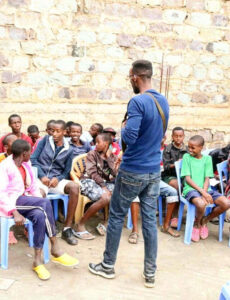Youth development is at the heart of all operations at The Scea Development. Child and or youth development is a nonlinear and multi-dimensional trajectory. Just like full human development is. The development of children’s and or young individual’s cognitive, mental, emotional, psychic and physiological capacities follows different paths. Some develop early whilst others late; meaning one shoe cannot fit all.
This calls for different thinking and application of appropriate and diverse teaching or pedagogical methods to help and enable stimulate the learning and development capacities of these young individuals or soccer hopefuls under our guidance. Since program inception in 2015, it has come to our understanding that differentiating instruction guise teaching to meet individual learner or athlete needs. The focus is to instill problem solving skills in our young athletes by manipulating practice and learning environments, tasks and performers to make them think outside the box, come up with their own solutions in regard to the challenges they face on and off the pitch.

In the photo footage are our young athletes in a psycho-social class; in 2019.
Skill acquisition, soccer intelligence or insight and fitness are all practiced on complex pitches and tight spaces. For example small sided soccer games of various forms like 5 vs 5, 5 vs 3, 4 vs 4, 3 vs 3 and 8 vs 8 among others are practiced on basketball courts (different surfaces). Players have to orient their bodies accordingly and also play without fouling the opponent as the courts’ playing surfaces are rough. The deliberate use of different playing surfaces for example courts for both volley and basketball besides small sized pitches on which handball is played helps and enables coaching staff to see the behaviors emerging from the players. The practice environment mirrors that of the real game which makes games easier or simpler for our players compared to any kind of opposition they face. We make our young defenders defend high up the pitch by placing small gated posts towards the halfway line ( a constraint or problem to overcome ) in a way trying to avoid fouls near the 18 yard box and also prevent corners.
Solutions are dependent on what players face and they’re the best architects to solve the challenges they face on and off the pitch. The passing, perception and decision making are done under very high pressure situations more or less than that in real matches. All these exercises are done within a defined framework of playing principles and freedom. Basic technique is practiced and repeated on a daily basis in all sessions with emphasis placed on the quality of pass and decision made under tight pressure. The weight, accuracy and reception (foot used) are of much importance in the way we train and develop players.
Since players are at different stages of development and come from diverse social cultural backgrounds, instruction is tailor made to meet learners’ needs on and off the pitch. Differential learning and or teaching is employed in this case in which a young player learns much through introduction of small variations or changes or distractions every time and again rather than the universally held truth that learning ensues best by repetition. In practice, players are exposed to more varied repetitions and complex tasks than the match provides which makes them solve the problems posed by opponents in real games more easily and effectively. Differentiating teaching is fundamental in capturing the non-linearity in player learning, development and performance in soccer. Based on the theory of ecological dynamics, a constraints- problem led approach to player development and education conceptualizes that skills best emerge through the interaction of different constraints (task – environment- performer). The movement behavior a player engages ion best emerges from a constant and dynamic search for movement stabilization within the environment of performance.
Brain based learning (BBL) is also essential towards player development at The Scea Development. In BBL, the cognitive, emotional, motivational and attention capacities of each individual learner are put at the forefront in all practice sessions and learning activities off the pitch. Practice exercises are designed to improve the organization of the brain which enhances quicker decision making and increased accuracy of player movement. By utilizing BBL, we get to improve a players’ speed of vision and execution improve. And since 205, we have come to a realization that when young individuals engage in motor activity, their respective neural pathways in the brain are stimulated; to this end visual images are more vivid which in turn strengthens muscle memory crucial to recalling certain skills and information related to certain actions. Our young players are exposed to the principle of bilaterality in physical exercise by using small balls which enable the brain to make connections with both sides of the brain as they move their bodies left and right. This impacts brain development and academic achievement for all ages.
